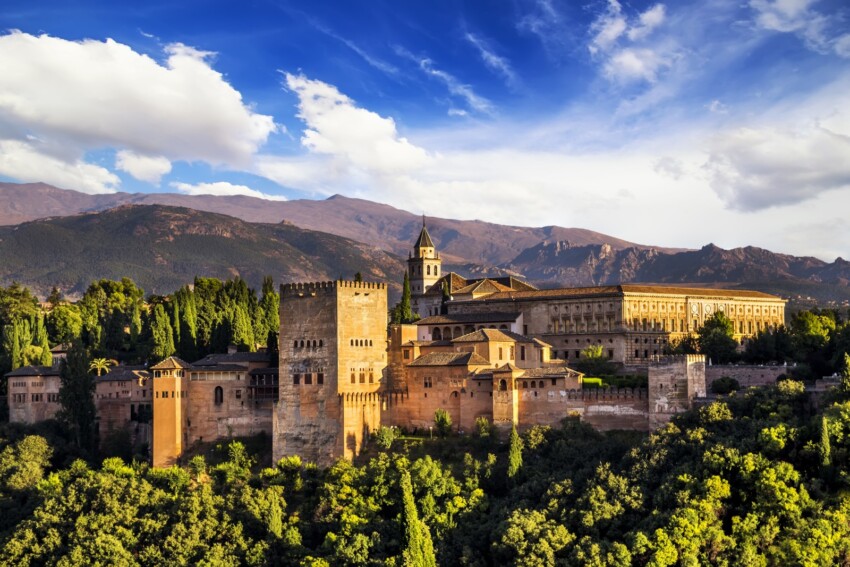

Visualise in your mind a romantic medieval town perched on hills, fill it with treasures from a thousand and one nights and in the background add majestic peaks covered in snow for most of the year: there you have the image of Granada, one of the ‘big three of Andalusia‘ along with Seville and Cordoba.
Evocative in dreams, Granada is an enchantment in life. It is no coincidence that it is one of the 10 most visited Spanish cities. Set in a scenic location at the foot of the Sierra Nevada mountains, between the Darro and Genil rivers, it is a city rich in history and romance.
It was the last city reconquered by the Catholic Monarchs in 1492 or, put another way, it is the city where Arab domination lasted the longest. The most important testimony of this long domination, but by no means the only one, is the magnificent Alhambra, a fortified citadel that hides wonderful palaces and gardens inside.
And then there is the other face of the city, the lively and festive one. Home to a major university, Granada is home to a lively community of university students and is full of clubs open from aperitif time until late at night.
Anyone who has been there agrees that it is a magical place, with a unique atmosphere, that steals your heart and is never forgotten: come and find out if you think so too.
For many tourists, especially day-trippers, a visit to Granada is synonymous with a tour of the Alhambra. But it would be a shame to leave without getting lost in the streets of the Arab quarter, to enter the gypsy quarter‘s cave dwellings, to search among many Moorish palaces for masterpieces of Catholic architecture and splendid Renaissance buildings. There is also a very atmospheric Jewish quarter, the Realejo.
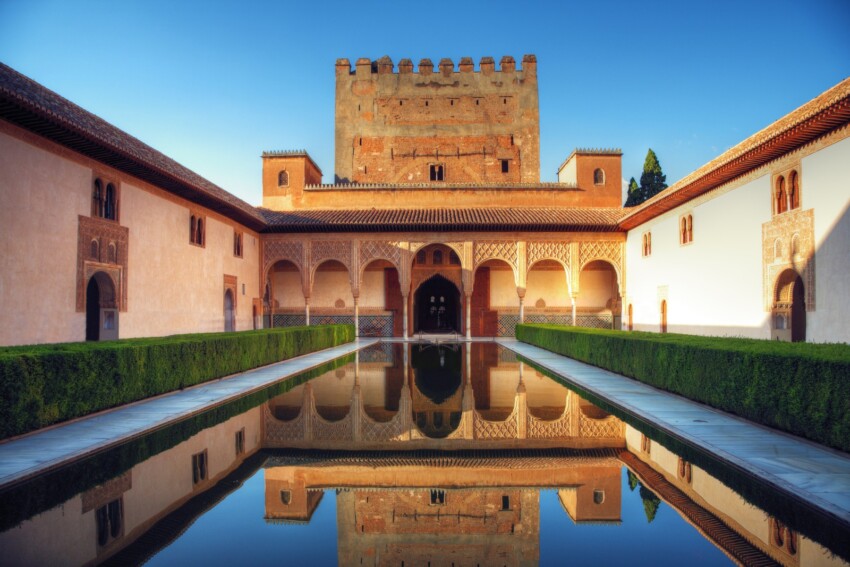
The Alhambra in Granada is an architectural jewel that enchants every visitor with its timeless beauty and historical charm. It dominates Granada from above and represents the pinnacle of Moorish art in Spain. Strolling through its flower-filled gardens and gushing fountains, one is transported to a time of sultans and princesses, of exquisite stucco decorations and intricate geometric patterns.
The Lion’s Courtyard, with its iconic fountain surrounded by twelve marble lions, is just one of the many striking corners that will make your visit unforgettable. The Hall of the Ambassadors, with its walls covered in poetic inscriptions, will leave you breathless, while the gardens of the Generalife, with their perfectly manicured hedges and panoramic views of Granada, offer an oasis of peace and beauty.
Visit the Alhambra and immerse yourself in the history and culture of one of the Mediterranean’s most fascinating civilisations. Every step inside this extraordinary monument will tell you a story of art, power and wonder. Don’t miss the opportunity to explore one of the world’s most iconic sites, where past and present meet in an eternal dance of beauty and wonder.
The Alhambra is enough to justify a trip to Granada. But this is only the top attraction, to which there are many other things to see.
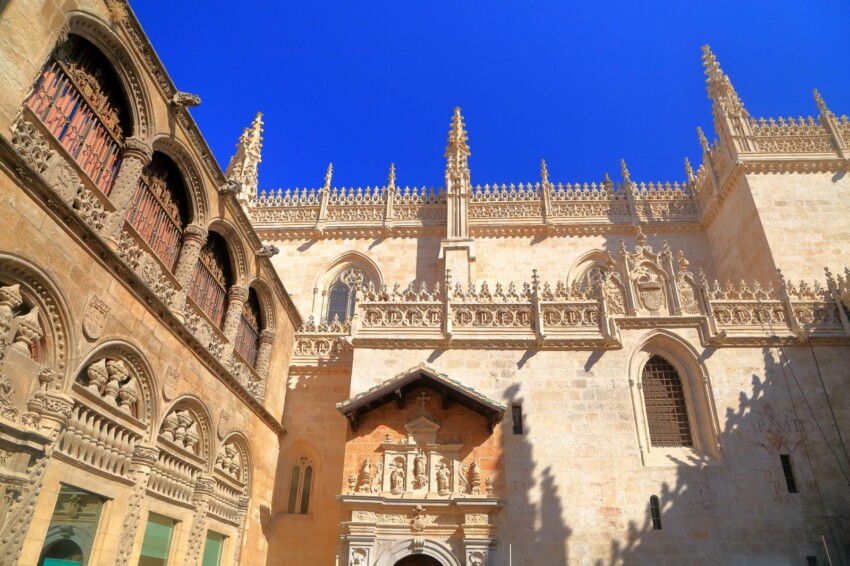
Granada is always associated with Arab architecture, in reality there are also splendid buildings of Christian architecture in the city. The most beautiful is considered to be the Capilla Real, a late Gothic building that has become a symbol of the end of an era and the beginning of a new phase in the history of Spain.
The church was built between 1506 and 1517 to honour a wish of the sovereigns of Spain Isabel and Ferdinand: for the two Catholic Monarchs, the city of Granada had a deep symbolic meaning as it marked the end of the Reconquista against the Arab rulers and for this reason they wanted to be buried here. Even today their remains are preserved in the Royal Chapel of Granada together with those of their daughter Joan the Mad and her husband, Philip the Fair, plus other members of the royal family (9 in total).
The sacristy of the Royal Chapel houses a small museum displaying objects that belonged to the Catholic Monarchs, including Isabella’s sceptre and mirror, Ferdinand’s sword, the silver crown and their personal collection of artwork.
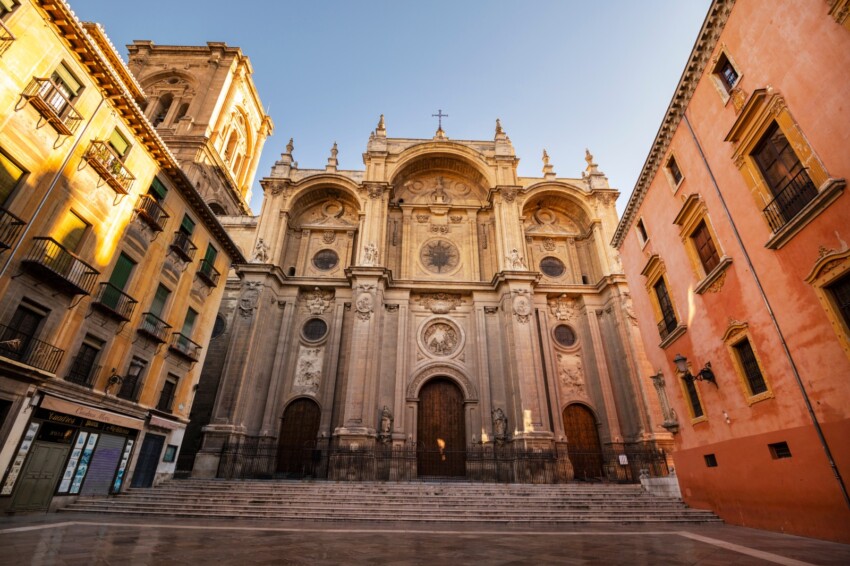
The Catedral Metropolitana de la Encarnación, more simply called the Cathedral of Granada, is the city’s other masterpiece of Catholic religious architecture. It is an imposing church built in the 16th century on the remains of an ancient mosque and has become a symbol of the Catholics’ victory over the Arabs.
It has considerable dimensions – the plan measures 115 x 65 metres – and was conceived as part of a monumental complex that includes the Royal Chapel and other important buildings including the Lonja, the Sagrario parish, and the San Fernando College.
Construction lasted about two centuries and this explains the mixture of styles: the main façade, overlooking Plaza de las Pasiegas, is Baroque while the interior is Gothic-Renaissance in style.
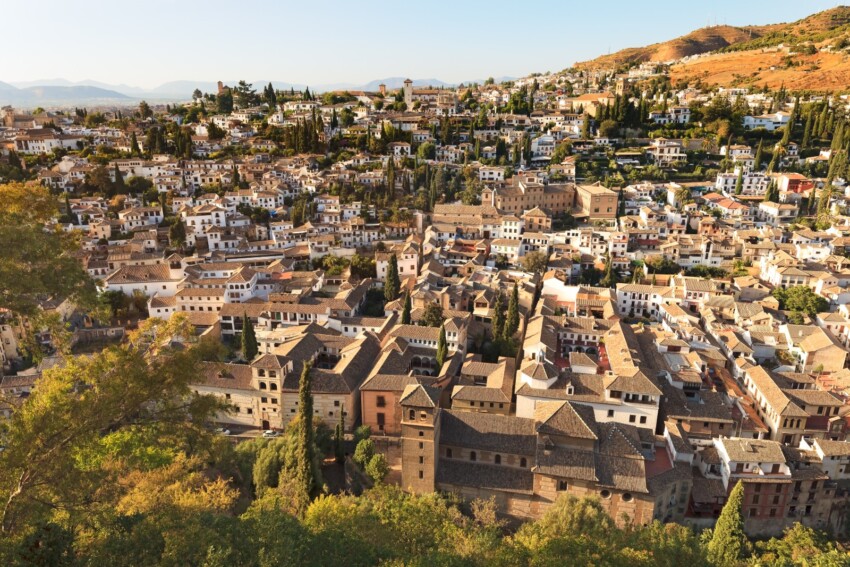
One of the most characteristic quarters of Granada is the Albayzin, a maze of narrow streets and small white houses perched on a hill opposite the Alhambra. It is sometimes referred to as the Arab quarter and in fact its intricate urban layout is very reminiscent of a medina.
Strolling aimlessly through the streets of the Albayzin in search of romantic views, small squares, panoramic terraces, rainwater cisterns and gates that hint at patios and lush gardens is one of the must-see experiences in Granada.
Some of the most beautiful buildings and spots that can be admired during a walking tour of the district include Plaza de San Miguel Bajo, Casa de Chapiz, Casa de Zafra, Palacio de los Cordova, Paseo de los Tristes. Also note the San Salvador viewpoint: from here you can enjoy one of the most beautiful views of the Alhambra.
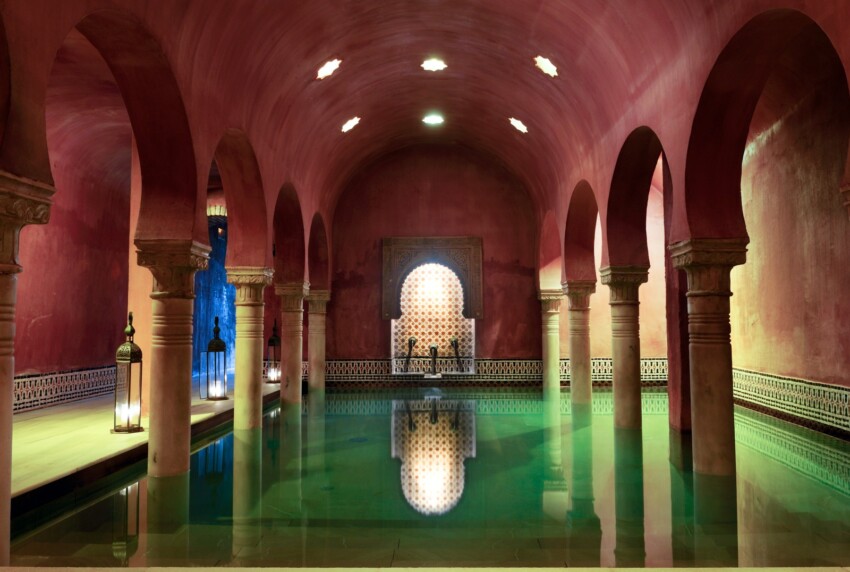
The Arab baths inside the Alhambra are unfortunately incomplete. If you want to see a magnificent example of perfectly preserved Arab baths, visit one of the most famous attractions in the Albayzin district: the Hammam al-Yawza or Baño del Nogal, better known as Bañuelo de Granada.
Although less lavish than those of the Alhambra, the Arab baths of the Albayzin are extremely elegant and functional at the same time.
Unlike almost all other Arab baths in Spain, which were destroyed by the Catholic Monarchs during the Reconquista because they were considered immoral, these were saved because they were built underneath a house that served as a roof and from which they can still be accessed today.
The baths are open to visitors but are no longer functional. You can try the hammam experience in some modern spas with Arabic-style rooms.
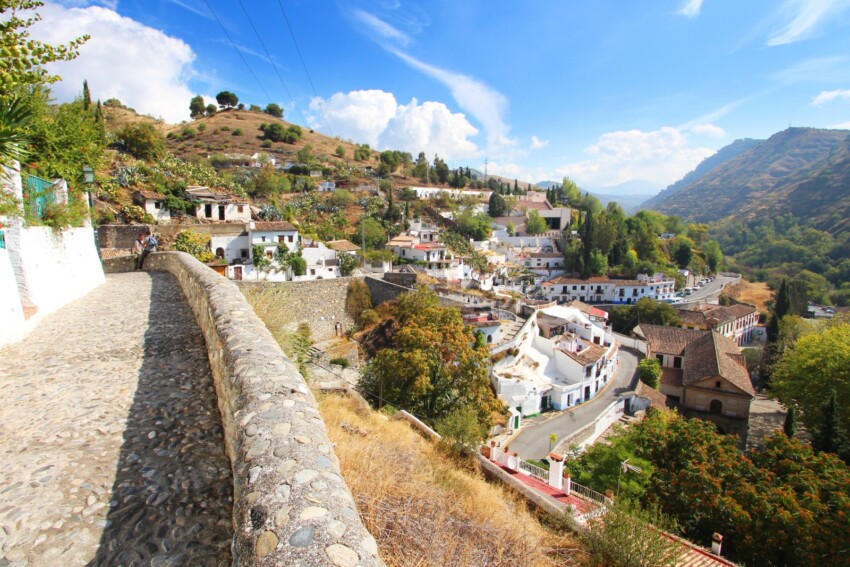
Another characteristic area of Granada worth exploring is the Sacromonte, famous as the ‘gypsy quarter’ because a community of Spanish gypsies settled here centuries ago and even today the area retains a distinctive atmosphere, quite distinct from that of the other districts.
Situated on the Valparaiso hill, close to the Arab quarter, it can be reached on foot from the centre of Granada but be prepared for a steep climb.
Sacromonte’s best-known attraction are the cuevas, houses built inside rock quarries; many of these have been converted into b&b’s and tablao de flamenco (typical places where flamenco music and dance performances are held).
During the day, Sacromonte is a very quiet neighbourhood, while at night, when the clubs open and tourists flock to the dance shows, it becomes a very lively area.
Another attraction not to be missed in the Albayzin is the Convent of Saint Isabel housed inside the Dar-al-Horra Palace. It is a particularly interesting attraction because it is one of the few buildings in the Albayzin to have retained its original appearance.
As the name suggests, it was Queen Isabella who converted the palace into a monastery; it remained a religious building until the 20th century.
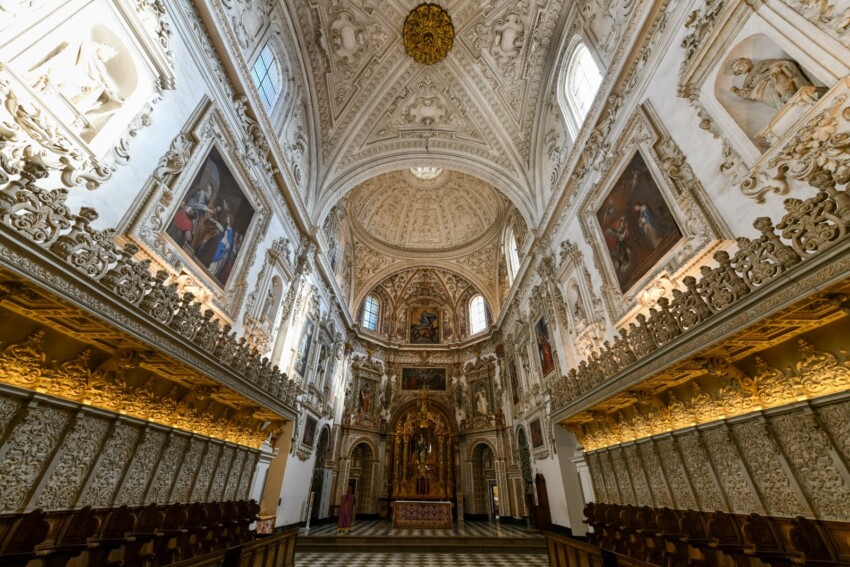
To learn more about religious architecture in Granada, add the Monastery of La Cartuja to your travel plans.
The original design, dating back to medieval times, envisaged an austere church, but work did not begin until the early 16th century, by which time the tastes and needs of the patrons had already changed dramatically. What we can admire today is one of the finest examples of late Spanish Baroque.
Granada is not only a treasure trove of artistic and architectural treasures, but also a city of great importance for Spanish literature. Federico Garcia Lorca, one of Spain’s most famous poets and playwrights and a staunch supporter of the Republican forces during the civil war, was born in a small provincial town.
To the great writer, the city of Granada has dedicated a lovely 71,500 square metre urban park surrounding the Huerta de San Vicente, the former summer residence of the Garcia Lorca family now converted into a house-museum.
Inside the house, time seems to have been frozen. In particular, the bedroom has remained almost identical to how it was left by the writer, who was shot by Francoist forces in 1936. The family remained here until 1942, when they were forced into exile in the United States.
During the visit you can see numerous objects that belonged to the writer in their original arrangement, such as the piano that Federico used to compose melodies to play to his grandchildren, the desk in his room where he wrote some of the most important works of his maturity and a gramophone. There is also period furniture and photographs.
An upstairs room has been used as an exhibition room to house temporary exhibitions and a permanent collection of the writer’s manuscripts, drawings and photographs.
Although it is only a small portion, moreover not original, of the old Moorish silk market, the present Alcaiceria Market in Granada is worth a visit for its colourful shops.
The original market dates back to the 15th century and was destroyed by fire five centuries later. Today’s market is reduced to a single, narrow street lined on both sides with shops selling fabrics, clothes, accessories and souvenirs.
In the following map you can see the location of the main places of interest mentioned in this article.
Discover Granada through the eyes of expert guides who will take you on a tour of the city's hidden treasures. Participating in a guided visit or a free tour will allow you to capture the true essence of Granada.
The free tours are a viable alternative to traditional guided tours. They work like this: participation is free and at the end of the visit you can leave a tip at your discretion. Below you will find our favourite free tour, otherwise you can see the full list by visiting this page.
The Sacromonte caves, Granada’s gypsy quarter, offer the most authentic setting to experience flamenco. Here, in ancient caves carved into the rock and transformed into tablaos, performers pass on a centuries-old tradition.
The most renowned shows are held in historical venues such as the Cueva de la Rocío and the Venta El Gallo, where cante jondo (deep singing), flamenco guitar and the vibrant zapateado come together in performances charged with duende – that magical energy that characterises true flamenco. Performances, often accompanied by traditional dinners, generally begin after sunset.
The most popular activities in Granada are certainly the guided tours of the Alhambra and the city walking tours. But Granada offers many other interesting activities with which to fill the programme of a holiday. For a start, you don’t necessarily have to walk around the city: you can take a segway tour, which is much less strenuous! And after the tours, why not treat yourself to a massage in a spa housed in a Moorish building?
If you stay in Granada for several days, take some time to explore the surrounding area: it is rich in scenic and cultural attractions. Choose from adventurous 4×4 excursions in the Sierra Nevada, romantic tours of mountain villages and day treks to fascinating locations such as the Caminito del Rey or the canyon of Los Cahorros de Monachil.
Fancy the sea? Treat yourself to a catamaran cruise on the Costa Tropical.
Not staying in Granada for at least one night would be a real shame: the hotels and B&Bs in this city are among the most charming in Spain. The options for an unforgettable stay are many and affordable. In fact, despite being very touristy Granada is not particularly expensive and it is possible to find good quality accommodation in all price ranges.
The centre is always the favourite area for travellers because it allows you to reach all the main tourist attractions in a short time and to have a large number of tapas bars, restaurants and places to spend the evening. In the case of Granada, sleeping in the centre also means being able to find rooms with views of the Alhambra and mountain backdrop, something that will certainly remain in your memory!
Instead of seeing the Alhambra do you want to ‘experience’ it? Book a hotel on the Alhambra hill, close to the city’s most beautiful Moorish palaces. Beware, however: this area is dominated by parador and luxury hotels in historic buildings, perfect for a romantic getaway or to celebrate something special but not suitable for those looking for budget accommodation. If you belong to the latter category, look in the centre or in the Jewish quarter.
Another unique experience worth considering is sleeping in a hotel converted from a cueva in the Sacromonte district. If, on the other hand, you want to soak up the Arab atmosphere, look for your hotel or guesthouse in the Albayzín district.
For those arriving by car, the centre and other historical districts can be problematic due to narrow streets and a lack of parking spaces. A good solution is the Camino de Ronda area, a long street close to the centre with a good choice of modern hotels and parking possibilities along the street. Less charming than the centre, it is, however, very convenient.
Granada is not located along the coast and is therefore not the best city for a beach holiday in Andalusia. However, if you stay in the city for several days you can combine cultural visits with a few afternoons of relaxation on the beach.
The province of Granada encompasses a stretch of coastline known as the Costa Tropical. Little known to international tourists, who flock to the more famous beaches of the Costa del Sol, it hides enchanting beaches and coves that are well worth discovering.
The most beautiful beach in the province of Granada is probably Playa de la Rijana, a dark sandy beach enclosed between two rocky promontories. It is a wild beach, with no facilities and not easy to get to, but it is well known so don’t expect to find it deserted; it can be reached by car from the centre of Granada in about an hour.
Other beaches not to be missed on the Costa Tropical are Playa Cañuelo, Playa Calahonda, Playa de la Guardia and Playa Granada.
The easiest and cheapest way to get to Granada is to take a low-cost flight: the airport is less than 20 km from the centre, is served by direct flights to/from our country and is well connected to the city.
If you rent a car after leaving the airport, simply take the A-92 motorway and in less than half an hour you will have arrived at your destination. For those who want to travel by public transport, there is a shuttle bus that connects the airport to the city centre in about 45 minutes.
Before buying your flight, also have a look at the low-cost flight offers of other Andalusian airports, especially Malaga.
If you are already in Spain, you can easily reach Granada by car or public transport from numerous locations.
Seville, Malaga, Cordoba, Barcelona and Madrid are well connected by both direct trains and buses. The journey time varies from one and a half hours for the nearest location (Malaga) to six hours for the furthest (Madrid). Granada’s train and bus stations are located a few kilometres west and north-west of the centre.
However, therental car remains the best option because it allows you to reach the province’s beaches, which are difficult if not impossible to reach by public transport, and to travel to the other cities of Andalusia more quickly.
What's the weather at Granada? Below are the temperatures and the weather forecast at Granada for the next few days.
Granada is a province in the eastern part of Andalusia, the region that occupies almost all of southern Spain. The capital city is located in the western hinterland of the province, at a distance of approximately 100 km from Cordoba, 125 km from Malaga and 250 km from Seville.